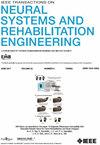一种新型脑机混合接口集成运动图像和多种视觉刺激。
IF 5.2
2区 医学
Q2 ENGINEERING, BIOMEDICAL
IEEE Transactions on Neural Systems and Rehabilitation Engineering
Pub Date : 2025-07-22
DOI:10.1109/TNSRE.2025.3591616
引用次数: 0
摘要
将运动意象(MI)与稳态视觉诱发电位(SSVEP)或显性空间注意(OSA)相结合的脑机接口(BCI)表现出比仅使用MI的脑机接口更优越的性能。然而,将脑机接口与视觉任务结合起来的脑机接口的探索仍然有限,而且脑机接口与视觉任务之间的同步性往往很弱。为了解决这一差距,我们的研究引入了一种新的脑机接口范式,该范式将MI与两个视觉任务(SSVEP和OSA)结合起来。在这个范例中,描述左臂和右臂运动的动态图像以不同的频率闪烁,作为位于屏幕两侧的视觉刺激。测试使用了四种分类方法。MI+SSVEP+OSA模式的平均准确率高于MI、MI+SSVEP和MI+OSA模式。这证实了我们的新范式的有效性,并证实了同时将MI与两种视觉刺激相结合的可行性。此外,我们观察到SSVEP的整合提供了显着的改进,特别是对于仅在MI范式中表现有限的参与者。此外,我们的结果表明MI+SSVEP和MI+OSA模式之间的性能相当。总的来说,本研究提供了有价值的见解,可以指导未来混合脑机接口发展的研究,为更高效、用户友好的脑机接口铺平道路。本文章由计算机程序翻译,如有差异,请以英文原文为准。
A Novel Hybrid Brain–Computer Interface Integrating Motor Imagery and Multiple Visual Stimuli
Brain-Computer Interface (BCI) that integrate Motor Imagery (MI) with Steady-State Visual Evoked Potentials (SSVEP) or Overt Spatial Attention (OSA) have demonstrated superior performance compared to MI only BCI. Nonetheless, the exploration of BCI that combine MI with visual tasks remains limited, and the synchronization between MI and visual tasks is often weak. To address this gap, our study introduces a novel BCI paradigm that combines MI with two visual tasks: SSVEP and OSA. In this paradigm, dynamic images depicting left and right arm movements flash at distinct frequencies, serving as visual stimuli positioned on both sides of the screen. Four classification methods are used for testing. The MI+SSVEP+OSA paradigm achieves higher average accuracy than the MI, MI+SSVEP, and MI+OSA paradigms. This validates the effectiveness of our novel paradigm and confirms the feasibility of simultaneously integrating MI with two visual stimuli. Moreover, we observe that the integration of SSVEP offers significant improvements, especially for participants who exhibit limited performance in the MI only paradigm. Additionally, our results indicate comparable performance between the MI+SSVEP and MI+OSA paradigms. Overall, this study offers valuable insights that can guide future research in hybrid BCI development, paving the way for more efficient and user-friendly BCI.
求助全文
通过发布文献求助,成功后即可免费获取论文全文。
去求助
来源期刊
CiteScore
8.60
自引率
8.20%
发文量
479
审稿时长
6-12 weeks
期刊介绍:
Rehabilitative and neural aspects of biomedical engineering, including functional electrical stimulation, acoustic dynamics, human performance measurement and analysis, nerve stimulation, electromyography, motor control and stimulation; and hardware and software applications for rehabilitation engineering and assistive devices.

 求助内容:
求助内容: 应助结果提醒方式:
应助结果提醒方式:


